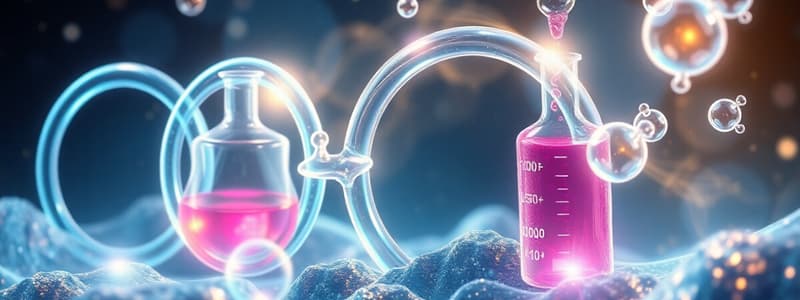Podcast
Questions and Answers
What is the primary purpose of isomerisation in the context of petrol production?
What is the primary purpose of isomerisation in the context of petrol production?
- To change straight-chain alkanes into isomers to increase octane number (correct)
- To produce longer-chain hydrocarbons from shorter ones
- To increase the carbon content of petrol
- To add oxygenates to enhance combustion
Which of the following statements accurately describes catalytic cracking?
Which of the following statements accurately describes catalytic cracking?
- It breaks down long-chain hydrocarbons into short-chain molecules (correct)
- It produces only alkenes from long-chain hydrocarbons
- It enhances the octane number without the use of heat
- It adds hydrogen to long-chain molecules
What is a common result of the dehydrocyclisation process?
What is a common result of the dehydrocyclisation process?
- The formation of carbon monoxide as a main product
- The creation of ring compounds accompanied by hydrogen loss (correct)
- The conversion of alkenes into alkanes
- The addition of oxygenates to hydrocarbons
Which method of hydrogen production is known for being expensive due to electricity costs?
Which method of hydrogen production is known for being expensive due to electricity costs?
Which statement correctly distinguishes between exothermic and endothermic reactions?
Which statement correctly distinguishes between exothermic and endothermic reactions?
What characterizes a saturated compound?
What characterizes a saturated compound?
Which of the following statements is true about hydrocarbons?
Which of the following statements is true about hydrocarbons?
What is the general formula for alkanes?
What is the general formula for alkanes?
What type of compounds are formed from the remains of ancient plants and animals?
What type of compounds are formed from the remains of ancient plants and animals?
Which of the following alkanes is a gas at room temperature?
Which of the following alkanes is a gas at room temperature?
What distinguishes structural isomers from one another?
What distinguishes structural isomers from one another?
Why are alkanes insoluble in water?
Why are alkanes insoluble in water?
Which alkane has the molecular formula C_6H_{14}?
Which alkane has the molecular formula C_6H_{14}?
What effect does ethyne have when burned?
What effect does ethyne have when burned?
What does the change in bromine water signify?
What does the change in bromine water signify?
What characterizes aromatic compounds?
What characterizes aromatic compounds?
Why is benzene considered stable despite being unsaturated?
Why is benzene considered stable despite being unsaturated?
What is the process called that separates crude oil into fractions?
What is the process called that separates crude oil into fractions?
Where in the fractional distillation column do larger molecules condense?
Where in the fractional distillation column do larger molecules condense?
What are refinery gases such as methane and ethane primarily used for?
What are refinery gases such as methane and ethane primarily used for?
What happens to smaller molecules during fractional distillation?
What happens to smaller molecules during fractional distillation?
What prefix is used when two identical alkyl groups are present in a molecule?
What prefix is used when two identical alkyl groups are present in a molecule?
What is the systematic name of the compound with five carbon atoms in the longest chain and two methyl substituents?
What is the systematic name of the compound with five carbon atoms in the longest chain and two methyl substituents?
Which of the following compounds is classified as an alkene?
Which of the following compounds is classified as an alkene?
Which characteristic is true about alkenes?
Which characteristic is true about alkenes?
Which statement about the naming of alkanes is correct?
Which statement about the naming of alkanes is correct?
What determines the position of substituents in a carbon chain?
What determines the position of substituents in a carbon chain?
How many carbon atoms are in the parent alkane for the compound named 2,4-dimethylhexane?
How many carbon atoms are in the parent alkane for the compound named 2,4-dimethylhexane?
Which compound is considered unsaturated?
Which compound is considered unsaturated?
What is the term used to describe the study of heat changes associated with chemical reactions?
What is the term used to describe the study of heat changes associated with chemical reactions?
What does a negative ΔH (delta H) indicate about a chemical reaction?
What does a negative ΔH (delta H) indicate about a chemical reaction?
Which device is specifically used to accurately measure heats of combustion?
Which device is specifically used to accurately measure heats of combustion?
What is the procedure followed in a bomb calorimeter to determine heat changes?
What is the procedure followed in a bomb calorimeter to determine heat changes?
What does the heat of neutralization refer to?
What does the heat of neutralization refer to?
How is the kilogram calorific value of a fuel defined?
How is the kilogram calorific value of a fuel defined?
What average energy does bond energy represent?
What average energy does bond energy represent?
When calculating ΔH, which of the following considers both bond breaking and bond forming energies?
When calculating ΔH, which of the following considers both bond breaking and bond forming energies?
What is the heat of combustion of propane compared to butane, based on their molecular sizes and intermolecular forces?
What is the heat of combustion of propane compared to butane, based on their molecular sizes and intermolecular forces?
Which of the following correctly defines structural isomers?
Which of the following correctly defines structural isomers?
What is the primary reason butane has a higher boiling point than propane?
What is the primary reason butane has a higher boiling point than propane?
What is the significance of the heat of combustion being negative for a reaction?
What is the significance of the heat of combustion being negative for a reaction?
What is the balanced equation for the complete combustion of butane when sufficient oxygen is available?
What is the balanced equation for the complete combustion of butane when sufficient oxygen is available?
What would be the effect of reversing the combustion equation of carbon dioxide on the ΔH value?
What would be the effect of reversing the combustion equation of carbon dioxide on the ΔH value?
How is the heat of combustion calculated using heats of formation?
How is the heat of combustion calculated using heats of formation?
In which of the following scenarios would the ΔH value for a reaction be positive?
In which of the following scenarios would the ΔH value for a reaction be positive?
Flashcards
Organic Chemistry
Organic Chemistry
The study of carbon-containing compounds.
Hydrocarbon
Hydrocarbon
A compound made only of carbon and hydrogen.
Fossil Fuel
Fossil Fuel
Fuel formed from ancient plants and animals.
Alkane
Alkane
Signup and view all the flashcards
Saturated Compound
Saturated Compound
Signup and view all the flashcards
Homologous Series
Homologous Series
Signup and view all the flashcards
Structural Isomer
Structural Isomer
Signup and view all the flashcards
General Formula for Alkanes
General Formula for Alkanes
Signup and view all the flashcards
Octane Number
Octane Number
Signup and view all the flashcards
Isomerisation
Isomerisation
Signup and view all the flashcards
Catalytic Cracking
Catalytic Cracking
Signup and view all the flashcards
Dehydrocyclisation
Dehydrocyclisation
Signup and view all the flashcards
Oxygenates
Oxygenates
Signup and view all the flashcards
IUPAC Nomenclature
IUPAC Nomenclature
Signup and view all the flashcards
Alkyl Group
Alkyl Group
Signup and view all the flashcards
Prefix 'di-' in Naming
Prefix 'di-' in Naming
Signup and view all the flashcards
Parent Alkane
Parent Alkane
Signup and view all the flashcards
Saturated Hydrocarbon
Saturated Hydrocarbon
Signup and view all the flashcards
Isomers
Isomers
Signup and view all the flashcards
Solubility of Alkenes
Solubility of Alkenes
Signup and view all the flashcards
Ethyne's combustion
Ethyne's combustion
Signup and view all the flashcards
Bromine water test for unsaturation
Bromine water test for unsaturation
Signup and view all the flashcards
What is an aliphatic compound?
What is an aliphatic compound?
Signup and view all the flashcards
Benzene ring
Benzene ring
Signup and view all the flashcards
Are all unsaturated compounds reactive?
Are all unsaturated compounds reactive?
Signup and view all the flashcards
What is fractional distillation?
What is fractional distillation?
Signup and view all the flashcards
Why are smaller molecules collected higher up?
Why are smaller molecules collected higher up?
Signup and view all the flashcards
What are refinery gases used for?
What are refinery gases used for?
Signup and view all the flashcards
Thermochemistry
Thermochemistry
Signup and view all the flashcards
Heat of Reaction (ΔH)
Heat of Reaction (ΔH)
Signup and view all the flashcards
Heat of Combustion
Heat of Combustion
Signup and view all the flashcards
Bomb Calorimeter
Bomb Calorimeter
Signup and view all the flashcards
Kilogram Calorific Value
Kilogram Calorific Value
Signup and view all the flashcards
Bond Energy
Bond Energy
Signup and view all the flashcards
Heat of Neutralization
Heat of Neutralization
Signup and view all the flashcards
What's the difference between exothermic and endothermic reactions?
What's the difference between exothermic and endothermic reactions?
Signup and view all the flashcards
What are structural isomers?
What are structural isomers?
Signup and view all the flashcards
Propane vs. Butane Boiling Point
Propane vs. Butane Boiling Point
Signup and view all the flashcards
Butane Combustion Equation
Butane Combustion Equation
Signup and view all the flashcards
ΔH for a Reaction
ΔH for a Reaction
Signup and view all the flashcards
Calculate ΔH from Enthalpies of Formation
Calculate ΔH from Enthalpies of Formation
Signup and view all the flashcards
Enthalpy of Formation
Enthalpy of Formation
Signup and view all the flashcards
How to Reverse a Reaction's ΔH
How to Reverse a Reaction's ΔH
Signup and view all the flashcards
Study Notes
Organic Chemistry
- Organic chemistry is the study of carbon compounds.
- Carbon forms stable rings and chains.
- Organic compounds are mostly covalent.
Hydrocarbons
- Hydrocarbons contain only carbon and hydrogen.
- Common sources include coal, natural gas, and petroleum.
- Fossil fuels formed millions of years ago from plant and animal remains.
Alkanes
- Alkanes are a family of saturated hydrocarbons.
- All atoms are linked by single bonds.
- Saturated compounds only have single bonds.
Molecular Formulae of Alkanes
- Methane (CH₄)
- Ethane (C₂H₆)
- Propane (C₃H₈)
- Butane (C₄H₁₀)
- Pentane (C₅H₁₂)
- Hexane (C₆H₁₄)
- Heptane (C₇H₁₆)
- Octane (C₈H₁₈)
- Nonane (C₉H₂₀)
- Decane (C₁₀H₂₂)
Homologous Series
- A homologous series is a series of compounds with similar properties, having a general formula where each member differs from the previous one by a CH₂ unit.
Isomers
- Structural isomers are compounds with the same molecular formula but different structural formulas.
Alkenes
- Alkenes are unsaturated hydrocarbons with carbon-carbon double bonds.
- General formula is CnH2n.
- Ethyne (C₂H₄)
- Propene (C₃H₆)
Alkynes
- Alkynes are unsaturated hydrocarbons with carbon-carbon triple bonds.
- General formula is CnH2n-2.
- Ethyne (C₂H₂)
Aromatic Hydrocarbons
- Aromatic compounds contain a benzene ring structure.
- Benzene (C₆H₆) is a common aromatic compound.
Oil Refining and its Products
- Crude oil is a mixture of hydrocarbons.
- Fractional distillation separates crude oil into fractions with different boiling points.
- Products include petrol, naphtha, paraffin, diesel, lubricating oil, bitumen.
- Fractional distillation uses a column with varying temperatures to separate fractions of crude oil into individual components.
Heat of Reaction
- Heat of reaction is the heat change when the number of reactant moles indicated in the balanced equation react completely.
- ΔH (delta H) represents the heat change.
- Exothermic reactions release heat (+ΔH)
- Endothermic reactions absorb heat (-ΔH)
- Heat of combustion is the heat change when one mole of a substance is completely burned in excess oxygen.
Octane Number
- Octane number measures a fuel's tendency to resist knocking (premature combustion).
- Higher octane numbers mean better fuel performance.
Catalytic Cracking
- Breaks down long-chain hydrocarbons into shorter ones.
- Achieved using heat and catalysts.
Studying That Suits You
Use AI to generate personalized quizzes and flashcards to suit your learning preferences.




